Do You know What Doctrine was Used to Establish American Law and the Constitution?

Did you know that American law is not based on the Ten Commandments?

East Stairway, U.S. House of Representatives, U.S. Capitol Building.
- Did you know that none of the U.S. founding documents mentions the Ten Commandments?
- Did you know that during the Constitutional Convention when our secular Constitution was adopted, the Ten Commandments were not mentioned once?
- Did you know there was no formal prayer at the Constitutional Convention?

THEN WHAT IS THE BASIS OF AMERICAN LAW?
Some Christians believe that American law is based on biblical law. One of their evidences is the claim that Moses and the Ten Commandments are prominently featured at the United States Supreme Court.But . . .
...... there is nothing in the design of the United States Supreme Court building that would indicate that the Congress, architect or designers had any special regard for the Ten Commandments.

The main entrance to the United States Supreme Court has no reference to religionor the Ten Commandments.
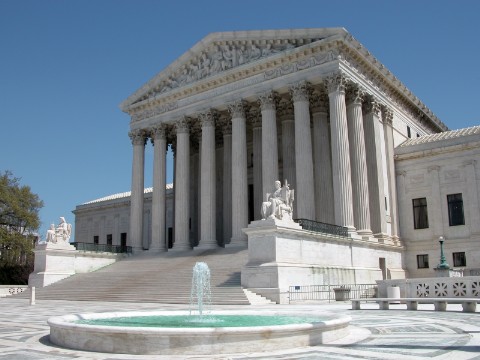
The large statues beside the steps do not represent any religious figures or concepts.
The sculptor, James Earle Fraser, considered those to be allegorical human figures. He described Contemplation of Justice (on the left, holding a smaller figure of blindfolded Justice) as a realistic conception of what I consider a heroic type of person with a head and body expressive of the beauty and intelligence of justice. He described Authority of Law as powerful, erect, and vigilant. He waits with concentrated attention, holding in his left hand the tablet of laws, backed by the sheathed sword, symbolic of enforcement through law.
The Ten Commandments expressly forbid the creation of such graven images.
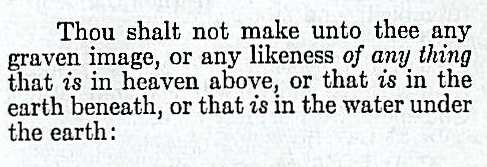
The carve d figures at the Supreme Court would be considered a form of idol worship under the Ten Commandments.
This is one of many evidences that American law ignores the authority of the Hebrew scriptures.
Authority of LawT he tablet held by Authority of Law does not represent the Ten Commandments. (The Ten Commandments are usually depicted by two tablets and Hebrew lettering.) The Latin word LEX (law) in this context refers to law in general.

The words Equal Justice Under Law (approved by Chief Justice Charles Evans Hughes) that appear above the steps to the Supreme Court are not a quote from any religious teaching, but a uniquely American phrase. It is taken from a sentence that appeared in the 1891 Caldwell v. Texas Supreme Court decision, which ruled that all citizens, under the Due Process clause of the 14th Amendment, are entitled to equal and impartial justice under the law. This principle is found nowhere in Judeo-Christian scripture. If the Ten Commandments were the basis of law, there would be no equal justice for nonbelievers or followers of other religions.
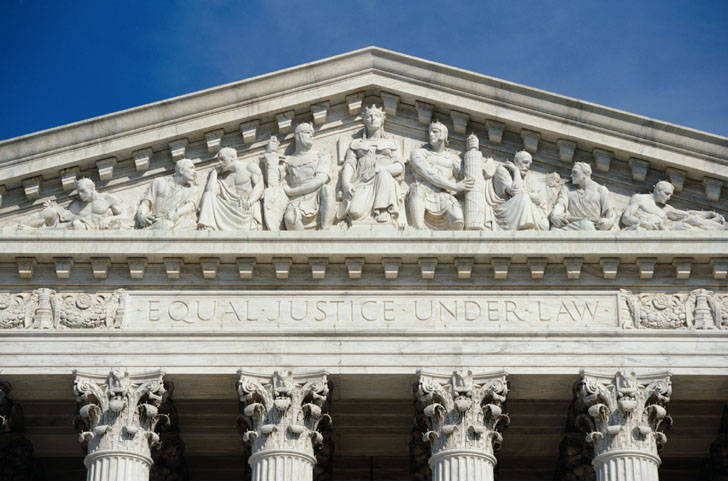
T he carvings above the main entrance to the Supreme Court represent no religious figures or teachings. Five characters are allegorical: Liberty (in the middle, with the scales of justice, a symbol that originated in Babylonia and Egypt and predated the writing of the Ten Commandments), Order, Authority, and two figures representing Council. The remaining individuals are candidly historical: Chief Justice William Howard Taft, Senator Elihu Root, architect Cass Gilbert, Chief Justice Charles Evans Hughes, the sculptor Robert Aitken, and Chief Justice John Marshall.
Robert AitkenRobert Ingersoll Aitken, the sculptor (whose namesake may have been the famous agnostic orator Robert Ingersoll), put himself into the Western Pediment (second from right). Whatever his personal views were, do you think that because Aitken's figure appears at the Supreme Court, American law is based on the views of Robert Aitken?
Front door of the Supreme CourtThe bronze doors at the front of the building, leading into the courtroom, contain no references to religion. (See footnote about Julian)
Inside door at the Supreme CourtThe official guides to the Supreme Court building explain to visitors that the Roman numerals I-X on the inner oak door of the Supreme Court refer to the Ten Amendments of the Bill of Rights (and not to the Ten Commandments) .
The Supreme CourtroomT he frieze on the wall above where the Supreme Court judges sit, depicting a seated figure beside a tablet with the Roman numerals I-X, does not represent Moses or the Ten Commandments.
East frieze, above the justicesSome believers mistakenly assume those are the Laws of Moses in the middle of the frieze. They forget that Moses reportedly had two tablets, that there would be no sun or eagle on top of the Ten Commandments, and that the Roman numbering system was not invented at the time the Hebrew scriptures were written.
 The designer of that frieze, Adolph Weinman, wrote a letter to the architect explaining that this graven image represents the Majesty of the Law, sitting beside the Majesty of Government, and that the Roman numerals I-X stand for the ten amendments of the Bill of Rights. [That letter is on file in the archives of the Supreme Court. It is unsigned because it was probably a copy for record-keeping.]
The designer of that frieze, Adolph Weinman, wrote a letter to the architect explaining that this graven image represents the Majesty of the Law, sitting beside the Majesty of Government, and that the Roman numerals I-X stand for the ten amendments of the Bill of Rights. [That letter is on file in the archives of the Supreme Court. It is unsigned because it was probably a copy for record-keeping.]

The Majesty of Government image to the right of the tablet is holding an ancient fasces (bundle of sticks) in his left arm. The fasces represented Roman law and authority and was carried much like the American flag is carried today. Since that image sits directly above the heads of the nine Justices (and another above the main entrance), do you think American law is based on the Roman fasces?
A lthough Moses is depicted inside the Supreme Court (fourth from left on the south frieze), he is not the central figure, but merely one of many great lawgivers of history on the South and North walls. Weinman placed Moses somewhat off to the side on the South frieze (not above where the justices are seated). Moses (holding two tablets) is standing among other allegedly historical lawgivers such as Menes (holding an Egyptian ankh), Hammurabi (who allegedly received his laws from the Babylonian Sun God), Solomon (who was wise enough to manage 700 wives and 300 concubines), Solon, the legendary Lycurgus (the central figure, who consulted the Oracle at Delphi), Draco, Confucius, Octavian, Justinian, Muhammad (the polygamist who claimed to have received Islamic law from the god Allah), Charlemagne, King John, the Crusader Louis IX (Saint Louis), Hugo Grotius, Sir William Blackstone, John Marshall, and Napoleon, as well as allegorical or mythical lawgivers such as the Greek goddess Fame, the Egyptian goddess Authority, the Light of Wisdom goddess, Equity, Philosophy and History.
Detail of Menes, Hammurabi and Moses, south friezeMoses is walking behind (not leading) Menes and Hammurabi in the south frieze. Menes was an Egyptian pharaoh and Hammurabi was a Babylonian king, both of whom worshipped a sun god.
North friezeIt was the designer, not Congress, who chose what images to represent on those friezes.
If the Ten Commandments were truly the basis of American Law, then why is Moses merely one of the throng of many lawgivers, real, legendary and allegorical? Since the other characters have as much prominence as Moses, why not consider American law to be based on the Greek Oracles of Delphi, or the sun gods of Mesopotamia and Egypt, or a book of philosophy, or the Koran?
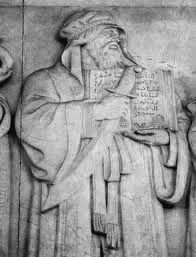

Muhammad and Moses stand almost directly opposite each other on the South and North walls, appearing somewhat off to the side on each frieze, and seem to be on par with each other .
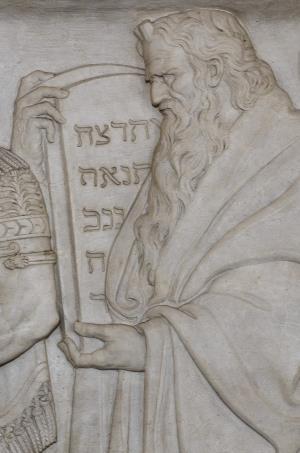
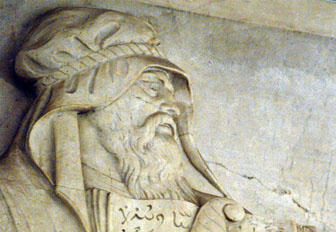
Muhammad is also depicted holding a so-called holy book.
The image contains Arabic letters from the Koran.Do you thinkthe artistic depiction of the words of a holy book at the Supreme Court make that book the basis for American law? If the Ten Commandments are the basis of American law because they appear in the Supreme Court, then why not the Koran? Or why not Roman law, since "LEX" appears at the front entrance?
Egyptian ankh, book of philosophy, owl, pagan lamp of wisdom, pagan scales of justiceThe artistic representation of the Ten Commandments tablets is only one of many other historical, religious, and mythical symbols that appear on those friezes. These mainly pagan symbols include or represent: the Egyptian ankh, the Roman fasces, a mirror, a rose, more than ten representations of the scales of justice, a dove, an owl (a symbol of wisdom in Greek, Roman, Indian and other pagan cultures, but not the Bible), harp, Greek scrolls of law, a book of philosophy, the Magna Carta, the Justinian code, an orb, the sword of a Crusader, at least eight more swords, more than one lamp, a scepter, and many other historical as well as mythical items.

While Moses is indeed depicted twice at the Supreme Court (outside and inside), so are Confucius and Solon. Moses is the central figure on the eastern pediment, the back of the building that few people see, facing away from the nation. Although Moses is central, certainly due to the fact that most European settlers of America came from a Judeo-Christian heritage, neither Confucius nor Solon are secondary in that image .
Confucius, Moses and Solon, Eastern pedimentThe designer of that eastern pediment gave secular reasons for that art. Sculptor Herman A. MacNeil wrote: "Law as an element of civilization was normally and naturally derived or inherited in this country from former civilizations. The 'Eastern Pediment' of the Supreme Court Building suggests therefore the treatment of such fundamental laws and precepts as are derived from the East." Neither Congress nor the sculptor claimed that American law is based on Confucius, Solon, or Moses. They merely acknowledge the unsurprising fact that American civilization, like all cultures, had many historical antecedents, having been settled by people from all over the world.
The pediment that is looking backward (to the east) contains Moses and myth while the pediment that is looking forward (west, above the main entrance facing the nation) contains no religious images.
The eastern pediment with Moses in the center is flanked by the Tortoise and the Hare from Aesops Fables. Those two fictional animals face Confucius, Moses, and Solon from either side.
Hare and Tortoise from Aesop's Fables, Eastern PedimentDo you thinkAmerican Law is based on Aesops fables orany story that personifies animals (such as a talking snake) can be the basis for law?
Would you thinkthat the fact that any particular image (such as Moses) appears at the Supreme Court is evidence that American laws were based on that character?

The purpose of the Ten Commandments was to establish the ancient nation of Israel, not the nation of the United States.
The purpose of the First Commandment was to declare which god among many (Elohim) was to be worshipped by the nation of Israel.
 The first four Commandments are religious edicts andhave nothing to do with law .
The first four Commandments are religious edicts andhave nothing to do with law .
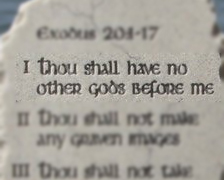
Actually, the First Commandment violates our Constitution.
The United States Government cannot tell citizens what god to worship, how many gods to worship, or that we should worship any god(s) at all. The phrase Thou shalt have no other gods before me contradicts the Bill of Rights. Breaking the first Commandment is not illegal under American law.
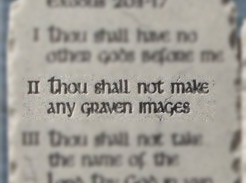
M aking graven images is not illegal under American law'

The second commandment violates the First Amendment guarantee of freedom of speech.
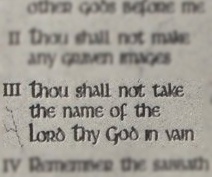 Taking the lords name in vain is not illegal under American law, sothis commandment also violates the freedom of speech.
Taking the lords name in vain is not illegal under American law, sothis commandment also violates the freedom of speech.
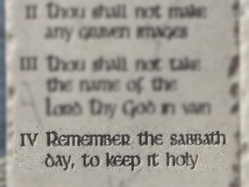
Failing to worship on the Sabbath is not illegal under American law, because our Bill of Rights guarantees freedom to practice or not practice any religion.

It is not illegal to dishonor parents under American law, a lthough respect and honor are good ideas, especially within a family, there is no American law that requires it.
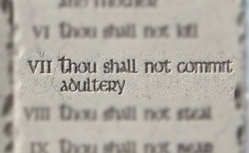
Adultery is not illegal under federal law, although adultery is a serious matter with social and moral consequences, it is not (and should not be) a federal crime in the United States.

It is not illegal to "covet" your neighbors property under American law.
(This commandment, if enforced, would undermine our entire system of free enterprise!)
If American law is based on Hebrew scripture, why are 70% of actions forbidden by the Ten Commandments legal in the United States?

Why will no officer of the law arrest you for any of these acts that were clearly prohibited by the ancient Israelites?
Could it be that American law is based on something else?
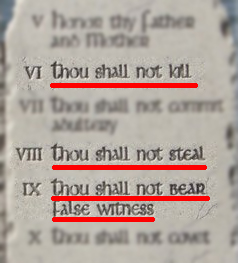
Only three of the Ten Commandments have any relevance to modern American law. These three humanistic precepts existed long before the ancient Israelites claimed the copyright.
American law allows for mitigating circumstances, degrees of homicide, self defense, while the Ten Commandments do not.Telling a lie is generally not illegal under American law (except in proscribed circumstances such as perjury and truth in advertising).
If you notice, you will see the Tenth Commandment insults women by classifying them with property, houses, slaves, and animals .
19th Amendment to the Constitution
1920
The right of citizens of the United States to vote
shall not be denied or abridged by the United States
or by any State on account of sex.
If American law is based on the Ten Commandments, why are women legally equal with men in this country?
The Supreme Court, following the Constitution, has declared that the Ten Commandments are undeniably a sacred text , but they may not be posted in public schools.
Wording fromStone v. Graham, 1980 No U.S. Supreme Court decision has ever been based on the Ten Commandments, and
decides whether an action or law is constitutional or unconstitutional, not whether it is biblical or unbiblical.
None of the U.S. founding documents mentions the Ten Commandments.
During the Constitutional Convention when our secular Constitution was adopted, the Ten Commandments were not mentioned once, there was not even aformal prayer at the Constitutional Convention.
WHAT IS THE BASIS OF AMERICAN LAW?
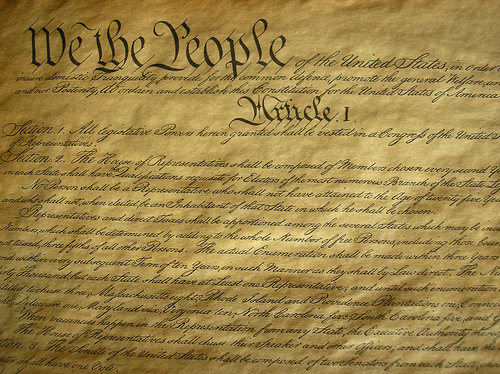
The basis of American Law is the U.S. Constitution, not the Ten Commandments or any religious teaching.
-------------------------------------------------------------------------------
First Amendment to the Constitution
Congress shall make no law respecting an establishment of religion,
or prohibiting the free exercise thereof;
or abridging the freedom of speech, or of the press;
or the right of the people peaceably to assemble,
and to petition the Government for a redress of grievances.
-------------------------------------------------------------------------------
The United States Constitution--the basis of American law--is a completely godless document.The only references to religion in the Constitution are exclusionary.
-------------------------------------------------------------------------------
U.S.Constitution, Article VI, paragraph 3
. . . no religious test shall ever be required as a qualificationto any office or public trust under the United States.
-------------------------------------------------------------------------------
The U.S. Constitution is not based on a king, deity, goddess, lord, monarch or sovereign authority.

The sovereign authority of the U.S. Constitution is "We, the people".
The "consent of the governed" (mentioned in the Declaration of Independence) is an anti-biblical concept.
Our secular Constitution is what makes the United States truly great!
This article wasoriginally published by Dan Barker for the Freedom From Religion Foundation , August 2012. Edited by Jerry Verlinger for The NewsTalkers August 2014



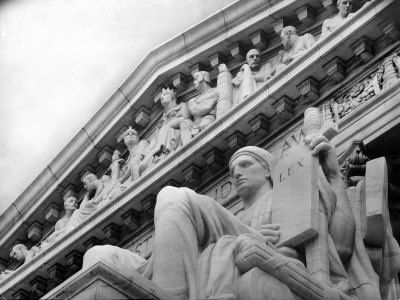

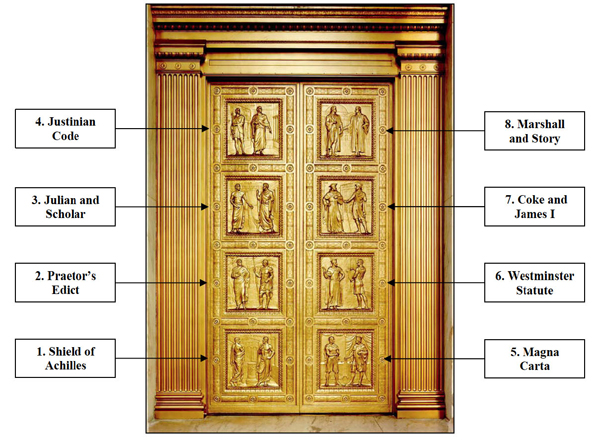

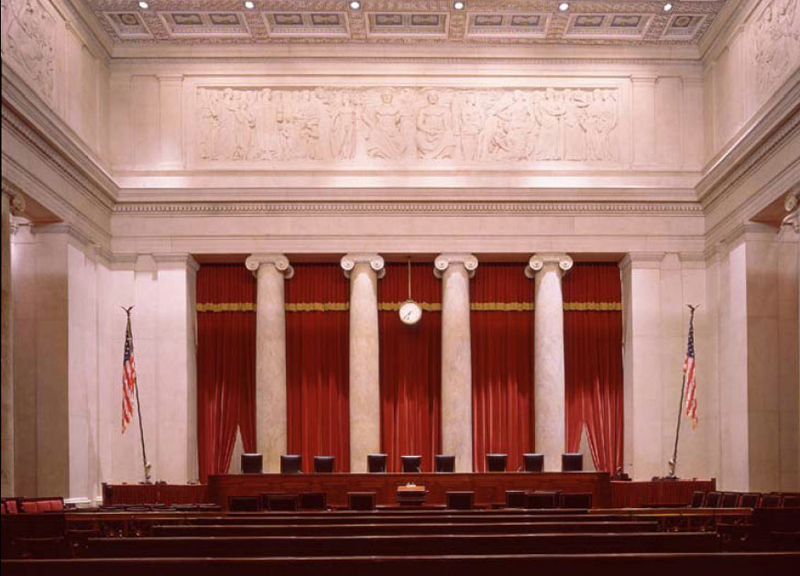










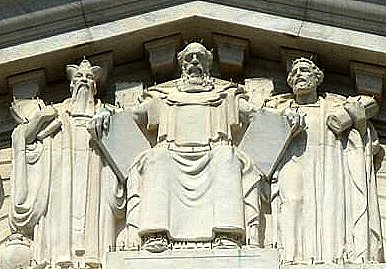

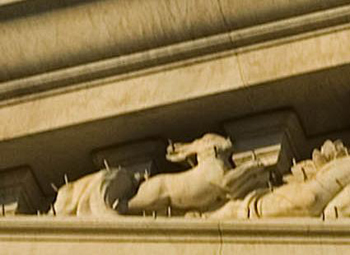
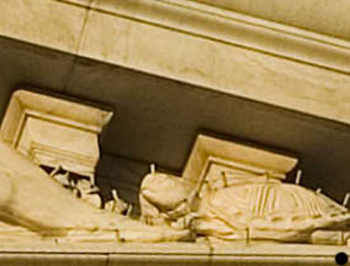
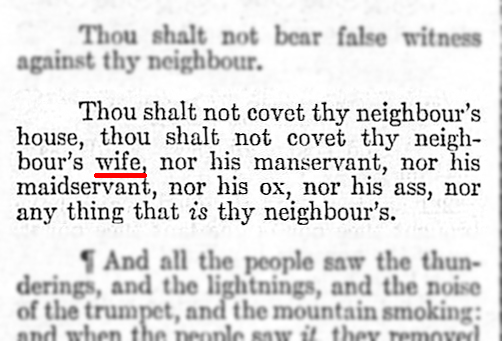
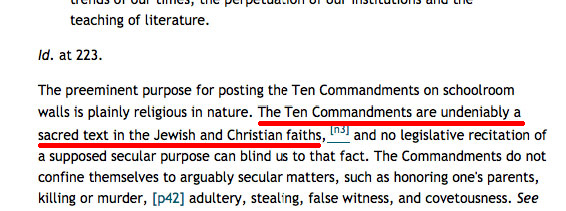





From the REFERENCES AND NOTES for this article;
Penalty for working on the sabbath
" Six days shall work be done, but on the seventh day there shall be to you an holy day, a sabbath of rest to the Lord: whoseoever doeth work therein shall be put to death. Ye shall kindle no fire throughout your habitations upon the sabbath day." (Exodus 35:2) For the chilling application of this law, see Numbers 15:32-36, where a man who picked up sticks on the sabbath was stoned, "and he died; as the Lord commanded Moses. "
Religious Symbols in the U.S. National Capitol
snopes.com/politics/religion/capital.asp
Yes-- Mohammed is depicted on the North Freize (despite the alleged Islamic prohibition of making images off him). I wonder if they will protest again and ask for it to be removed? (Remember the brouhaha over the "Mohammed Cartoons"?)
I wonder, perhaps it should be removed so as not to offend any Muslims?
U.S. law has its most basic origins in English common law, the principles of what is right and wrong
Wow - interesting question which leads to another one - why the interest?
In part, ''Doctrine of Discovery''.
Three sources - 1st, Magna Carta; 2nd, Iroquois Confederacy Law of Peace; 3rd, English Common Law.
If you want to post things that are interesting and appropriate for your title (which does not contain any religious/10 Commandments references), try looking at the Treatises and the Federalist Papers - you'll get the answer your title of the thread is asking for.
I tried to make it all the way through, but failed. Not sure where this question came from, Jerry, but it seems you have proved to yourself the answer to your question.
I was going to say English Common law, but someone beat me to it.
Thanks 1st. Many people believe the Constitution was based on the 10 commandments.
Why should the title refer to any references? Its a question. The article was originally published by Dan Barker for the Freedom From Religion Foundation, August 2012. I edited it and reposted it for The NewsTalkers, as noted in the footnote at the bottom of the article.
The grade level for all the people that believe the Constitution was based on the 10 Commandments and the Bible.
There ya go Robert. Actually, you seem to be a click or two below the target audience for this article.
Pay attention Spike. Footnote at the bottom of the article;
" This article was originally published by Dan Barker for the Freedom From Religion Foundation , August 2012. Edited by Jerry Verlinger for The NewsTalkers August 2014 "
The article was posted todispelthe notion held by many most Christians that the U.S. Constitution wasbased on the Bible and/or the 10Commandments.
It would be nice if we could use this article as a jumping off point for a discussion as to why the Constitution and language therein are like they are, instead of a jumping all over one another to see who the biggest prick is.
So, towards this end: 1st was correct when he said, "...1st, Magna Carta; 2nd, Iroquois Confederacy Law of Peace; 3rd, English Common Law."I would agree, though I had not considered the Iroquois Confederacy Law of Peace to be that prevalent on the thinking of the framers of the constitution. Maybe 1st would like to share some of his reasoning on that one.
The Magna Carta was a tremendously influential document, because it contained the seeds of the idea that Kings did not rule by Divine Right, but ruled by the grace of their subjects. Very important conceptually.
Of course, English Common Law was an extremely important place to start with the laws surrounding the Constitution and the methods used in the pursuit of Justice.
The Federalist Papers are documents published in the common press of the day (I believe, I could be wrong) containing arguments for and against certain parts of the constitution before its official enactment.
Wow, So many good questions......
Any polls or other information to confirm this statement? Or is this simply your opinion?
Indeed it would be nice Broliver, but the face of the article belies this statement.
However, lets continue with your thread. The Magna Carta did not pertain to peasants, only to titled lords. Still, it is a very important document.
The Constitution was also based a lot on plain thought and philosophical reflection. It is an amalgamation of thoughts from many directions and sources.
It's my opinion, an opinion shared by many;
Phil Plait - Discovery
Tina Dupuy - HuffPo
Citizen Tom
Then there is this fromfaithfacts.org/the-bible-and-government
THE BIBLE AND GOVERNMENT
Biblical Principles: Basis for America's Laws
Not to mention; when you have people like Sarah palin and Bill O'Reilly carry on conversations like this on the most watched cable news program in the county, it's easy to understand why so many people believe our Constitution is based on the Christian religion.
SARAH PALIN, FOX NEWS CONTRIBUTOR: I have said all along that America is based on Judeo-Christian beliefs and, you know, nobody has to believe me though. You can just go to our Founding Fathers' early documents and see how they crafted a Declaration of Independence and a Constitution that allows that Judeo-Christian belief to be the foundation of our lives. And our Constitution, of course, essentially acknowledging that our unalienable rights don't come from man; they come from God. So this document is set up to protect us from a government that would ever infringe upon our rights to have freedom of religion and to be able to express our faith freely.
O'REILLY: All I have to do is walk into the Supreme Court chamber and you'll see the 10 Commandments. And so we know that you're absolutely correct . [ Full transcript ]
The First Amendment in Five Minutes VERY WELL DONE (Video)
Federal Theology
Monday, May 23, 2011
God & Federalist Papers
FEDERALIST PAPERS
EXAMPLES OF FAITH-BASED EXPRESSIONS
|||
Founding Fathers Have Provided Significant Examples of Faith-Based Beliefs in Essays Arguing for Ratification of the Constitution.
It can be convincingly be argued that our US Constitution would not have been ratified had not the Federalist Papers convinced our country's founding fathers that it was in the interest of the thirteen individual states and of the United States, as a united whole, to do so.
Three of the founding fathers wrote jointly under the pen name of Plubius; Alexander Hamilton, James Madison, and John Jay published a series of 85 essays, beginning immediately after the Constitutional Convention of September, 1787. And by the following spring their effort had succeded, the Constitution had been ratified.
In light of the affront taken by a minority of law-makers, judges, and citizens to the inclusion of "One Nation under God" in our Pledge of Allegiance, a reading of the Federalist Papers can help dispel the fiction that our founding fathers envisioned a "fire-wall" between governance and theist or deist principles.
Knowing something of the factious temperment of people and the nature of people to divide with animosity over both frivolous and profound issues, our founding fathers did not shy away from initiating legislative measures in the Constitution that would work to minimize the power of any group or person, no matter their power, or numbers, or wealth.
Our founding fathers recognized that factions are elemental to the running of a government and they sought ways to minimize political and religious tyranny, but in writing the Federalist Papers they certainly expressed the country's clear connection with moral values and God.
Let us consider some of the ways in which the authors of the Federalist Papers display faith-based beliefs:
Essay 20, Topic 21, urges Americans to let their praise of gratitude for auspicious amity distinguising political counsels rise to heaven.
Essay 37, Topic 14, tells us that any person of pious reflection must perceive that in drafting the Constitution there is to be found in it a finger of that Almighty hand that has so frequently and signally extended to our relief in the critical stages of the revolution.
Essay 43, Topic 30, asserts that nothing is more repugnant than intolerance in political parties, stressing the importance of moderation the essay concludes that one cannot avoid a belief that the great principle of self-preservation is a transcendent law of both nature and God...
Essay 1, Topic 4, concludes that in politics, as in religion, it's absurd to aim at making proselytes by fire and sword. Heresies in either can rarely be cured by persecutions.
Essay 2, Topic 4, refers to God in three separate instances, referring to the country they wrote that God blessed it with a variety of soils, watered with innumerable streams, for the delight and accommodation of its inhabitants. In other instance the author makes note with equal pleasure that God gave this one connected country to one united people. And in a third instance wrote that it appears like this inheritance was designed by God for a band of breathern united by the strongest ties.
Essay 31, Topic 2, informs us that theorems may conflict with common sense. Mathematicians agree on the infinite divisibility of matter, the infinite divisibility of a finite thing, but that this is no more compreshensible to common sense than religious mysteries that non-believers have worked so hard to debunk.
Essay 37, Topic 10, addresses how difficult it is to express ideas and words clearly, without ambiguity. The task of clear writing is lameted, for when the Almighty himself condescends to address mankind in their own language, his meaning, luminous as it must be, is rendered dim and doubtful by the cloudy medium through which it is communicated.
Essay 44, Topic 24, sets forward the idea that there must be safeguards against the misuse of religion, in that no religious test shall ever be required as a qualification to any office or public trust under the United States.
Essay 51, lets us know that in a free government, the security for civil rights must be the same as that for religious rights.
Essay 57, Topic 6, briefly elaborates that no qualification of wealth, birth, religious faith, or civil profession is permitted to fetter the judgement or disappoint the inclination of the people.
The importance of the Federalist Papers in helping lay the foundation of the United States cannot be overestimated.
On one hand the authors expressed their faith-based beliefs but on the other hand they forged ahead in making certain that religion would not be permitted to divide the people or to otherwise tyrannize any individual or group.
However, by their very example in writing the Federalist Papers, its authors showed that while government may not make any law respecting an establishment of religion, expressions of faith-based beliefs are natural and wholesome whether in government or among the populace, the only criteria in government being to steadfastly remain within the expressed bounds of both the letter and spirit of the second amendment law.
Here ya go Brolly -
In 1988, the 100th U.S. Congress passed a concurrent resolution acknowledging the contribution of the Six Nations of the Iroquois Confederacy to the development of the U.S. government. This same spirit of acknowledging the influence of the ancient Iroquois on the new United States was captured poetically by Oren Lyons, chief of the Onondaga Nation, in an interview with Bill Moyers. Declaring Franklin a visionary who brought Indian ideas of democracy, freedom, and peace to America, Lyons said of the founding fathers:
In North America at that time, they took an ember, they took a light from our fire, and they carried that over and they lighted their own fire and they made their own nation. They lighted this great fire, and that was a great light at that time of peace.
For a more indepth reading and better understanding - go here -
Iroquois Confederacy Law of Peace.... and the U.S. Constitution
Also;
Gerald Murphy - Fordham university.
Modern History Sourcebook:
The Constitution of the Iroquois Confederacy
Excerpt;
" ... I DID find sufficient data and evidence to convince me that the Iroquois most certainly did have a considerable influence on the drafting of our own Constitution, and we present-day Americans owe them a very large debt ."
I was also surprised when I was doing the background for the article Broli, but it's for sure true.
Grade level has little or nothing to do with intelligence which you implied. Einstein is one of many examples. There are children with IQ's basically nocking the top of the scale. The question and article are relevant to todays police and religious leaders who are defying the Constitution. Thanks for the article.